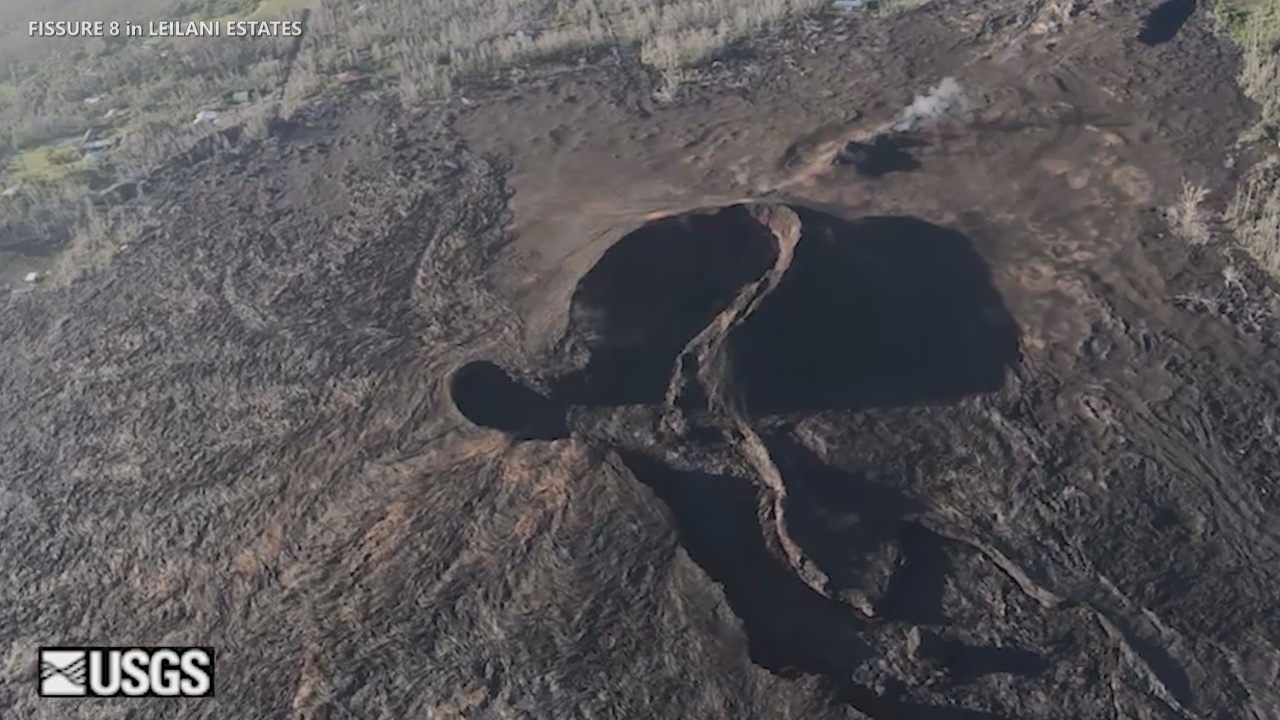
image from video recorded during a January 21 flyover of fissure 8 in Puna. (USGS video by M. Patrick)
(BIVN) – During a recent After Dark in the Park “Volcano Awareness Month” talk, the USGS Hawaiian Volcano Observatory Scientist-in-charge Tina Neal gave an update on the latest volcanic activity on Hawaiʻi Island, where things have been quiet since the summer of 2018.
Kīlauea is not erupting, and ever since June of 2019 the volcano has been at the NORMAL/GREEN alert level.
Neal said magma is returning to the East Rift Zone and to Kīlauea’s summit area. She presented a slide showing an interferogram, produced from radar satellite imagery, depicting inflation of the volcano. Neal says “it’s really a broad region in the middle-east rift zone that’s inflating or reflecting this accumulation underground.”
“Another important point about Kīlauea right now is that the gas emissions are at the lowest level they’ve been in a long time,” Neal said. “Just last week, we’ve measured only 40 tons a day of sulfur dioxide coming out of the summit. In the lava lake time, the numbers were up around 5,000 tons per day. So, the magma is deep enough that we’re not seeing a lot of sulfur dioxide at the surface.”
Neal also talked about the growing lake of water at the bottom of Halemaʻumaʻu crater, which is now a football field wide, two football fields long, and over 75 feet deep. She presented a slide on the potential hazard implications of the crater lake.
According to Neal, whenever you’re talking about hot magma potentially interacting with water, there is the possibility of explosions. “But we think at this point we won’t have explosions from magma/water interaction unless magma rises very rapidly into the lake,” she said. “We have seen no sign of that happening and we would expect to see changes before that happens, and even then we’re not sure – given the geometry and the volume – that there would actually be explosions, but it is a possibility we have to consider.”
“Especially after the New Zealand eruption a few weeks ago,” Neal added, referring to the deadly December 9 eruption on Whakaari, “people have asked if that could happen here and our answer is that it’s a very different system here. This is a much leakier volcano. There’s no sign that the system is sealing and pressurizing under some sort of impermeable cap, like happened at that White Island volcano in New Zealand.”
Kīlauea’s water lake is not at sea level, Neal said, so “it’s got a different composition. The rocks are of a different chemistry, so the minerals precipitating are not high in silica and they’re not likely to clog up the pore spaces in the same way.”
“So the short answer is we don’t think we have a White Island situation developing here,” Neal said, “but we can’t completely rule out the possibility that there will be sudden steam explosions at some point. So this is something we’re considering as we go forward.”
Still, overall Kīlauea is quiet, and Neal says its “possible we’ll have many years of quiet before the next eruption. Many years. A year; five years. Its hard to say. Based on past patterns, following big events like 2018 it’s most likely that the next eruption would be in the summit area. That’s about all we can say with certainty.”

by Big Island Video News4:24 pm
on at
STORY SUMMARY
HAWAIʻI VOLCANOES NATIONAL PARK - The summit lake is not expected to trigger an explosion like the one on White Island in New Zealand, but scientists can't rule out the possibility that there will be sudden steam explosion at some point.